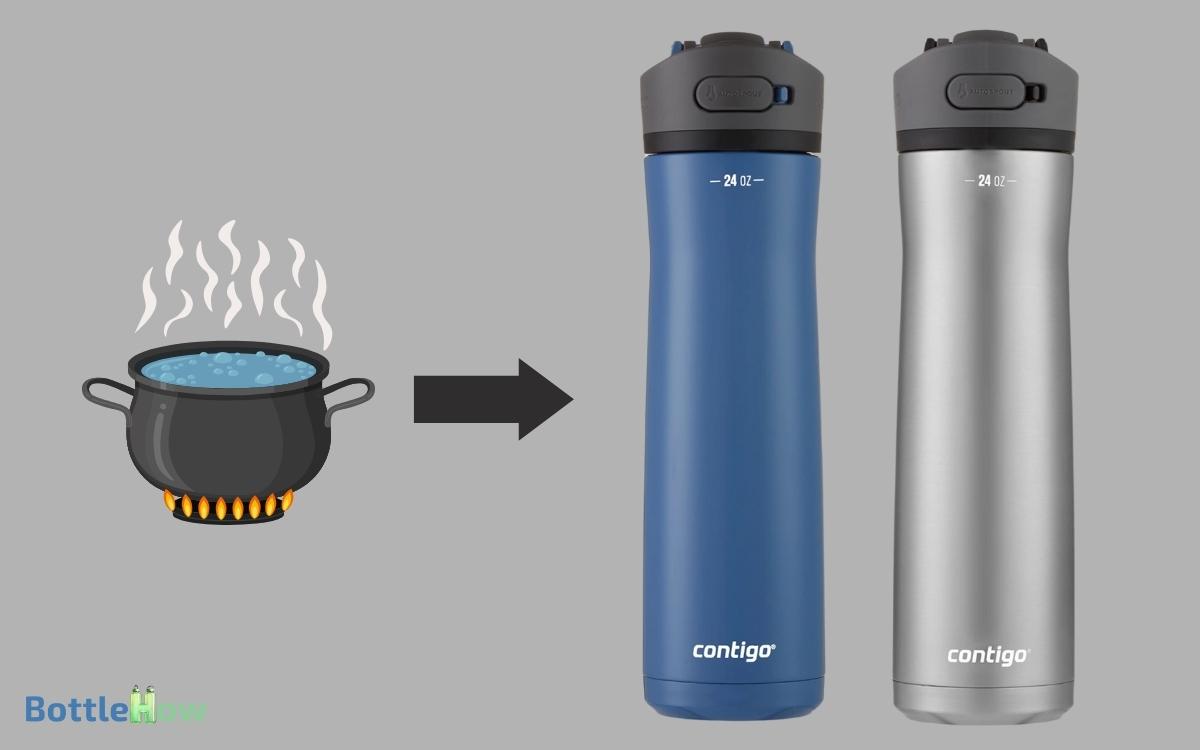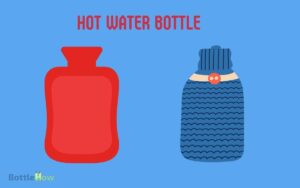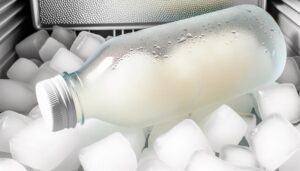Can You Put Hot Water in a Contigo Water Bottle? Yes!
You can put hot water in a Contigo water bottle if you follow the manufacturer’s guidelines. The stainless steel body and BPA-free plastic lids with silicone seals are designed to handle high temperatures, but you should keep the water below 190°F.
Make sure the lid is fastened securely and open it slowly to let steam escape, preventing pressure build-up. Regularly inspect the seals and use caution when handling hot liquids to avoid spills.
Additionally, proper cleaning with warm, soapy water is essential for maintaining bottle integrity. Explore further for detailed usage tips and safety considerations.

Key Takeaways
Understanding Contigo Bottle Materials
Have you ever wondered what materials make up your Contigo water bottle and how they handle hot liquids?
Contigo bottles typically use stainless steel for their main body, providing durability and resistance to corrosion. This material can withstand high temperatures without degrading.
The lids are usually made from BPA-free plastic, which is heat-resistant but may have limitations with very hot liquids. Silicone seals are incorporated to prevent leaks and guarantee a tight fit.
These seals are also heat-resistant but could degrade over time if exposed to extreme temperatures repeatedly. Understanding these materials is important because each has specific tolerances.
Knowing their properties helps you use your Contigo bottle safely and effectively, especially when dealing with hot liquids.
Manufacturer’s Guidelines
When using a Contigo water bottle for hot liquids, you should adhere to the manufacturer’s guidelines. Pay attention to recommended temperature limits and make sure the materials meet safety standards.
Follow usage and maintenance tips to maintain the bottle’s integrity and performance.
Recommended Temperature Limits
Contigo’s manufacturer guidelines stipulate that the water bottle can safely hold liquids up to 190°F (88°C). This temperature limit ensures that the bottle maintains its structural integrity and prevents accidental burns. While it is designed to handle hot liquids, extreme temperature changes, such as freezing, are not recommended. If you’re wondering, can you freeze Contigo bottle, the manufacturer advises against it, as freezing can damage the bottle’s seals and insulation.
You should always verify that the temperature of the liquid doesn’t exceed this limit to avoid potential damage to the bottle and guarantee user safety.
Please be aware that while the bottle can hold hot liquids, surpassing the recommended temperature limit can compromise its integrity and performance. Test the liquid temperature with a thermometer before pouring it into the bottle.
Additionally, exercise caution when handling the bottle with hot liquids inside, as the exterior may become warm to the touch.
Adhering to these guidelines will help preserve the bottle’s functionality and prolong its lifespan.
Material Safety Standards
As per the manufacturer’s guidelines, it’s important to verify that the Contigo water bottle complies with all relevant material safety standards before using it for hot liquids.
Specifically, you should confirm that the bottle’s materials can handle high temperatures without degrading or releasing harmful chemicals.
Key considerations include:
- BPA-Free Certification: Confirm that the bottle is free from bisphenol A, a harmful chemical that can leach into liquids at high temperatures.
- Thermal Stability: Check the manufacturer’s specifications for the maximum temperature the bottle can safely withstand.
- Food-Grade Materials: Verify that all components, including the lid and seals, are made from food-safe materials.
Adhering to these guidelines guarantees safe use of your Contigo water bottle.
Usage and Maintenance Tips
Always follow the manufacturer’s instructions to maintain the integrity and functionality of your Contigo water bottle. Avoid using abrasive cleaners or scrubbers, which can damage the bottle’s surface.
Hand-wash the lid and bottle with mild detergent, as dishwasher use might compromise seals and insulation. Ensure all parts are thoroughly dried before reassembly to prevent mold growth.
When filling with hot liquids, don’t exceed the maximum fill line to allow for steam expansion. Regularly inspect the seals and spouts for wear, replacing them as necessary to avoid leaks. Adhering to these guidelines guarantees your Contigo bottle performs at its best and lasts longer.
Always consult the user manual for specific care instructions tailored to your model.
Heat Resistance of Contigo Bottles
When considering the heat resistance of Contigo bottles, you should examine their material construction and temperature retention capabilities.
These bottles are typically designed to handle hot liquids, but it’s important to adhere to safety precautions.
Always make sure you’re following the manufacturer’s guidelines to maintain both the bottle’s integrity and your safety.
Material Construction Details
Contigo water bottles are crafted from high-quality stainless steel or BPA-free plastic, which are designed to withstand varying temperature levels, including hot liquids.
The stainless steel variants typically feature double-wall vacuum insulation, providing a robust barrier against heat transfer.
The BPA-free plastic options utilize Tritan material, known for its durability and resistance to high temperatures.
To guarantee the bottle’s longevity and your safety, it’s crucial to understand the material’s specific heat resistance properties.
Stainless Steel: Double-wall vacuum insulation prevents heat transfer, maintaining structural integrity.
BPA-Free Plastic (Tritan): High-temperature resistance, though not as effective as stainless steel.
Seals and Lids: Designed to endure heat, ensuring no leaks or damage occur when filled with hot liquids.
Always check the manufacturer’s guidelines for detailed specifications.
Temperature Retention Capabilities
You’ll find that Contigo bottles excel in temperature retention due to their advanced insulation technologies.
By using double-walled vacuum insulation, these bottles can maintain hot water temperatures for hours.
Specifically, they can keep liquids hot for up to 12 hours, depending on the model and external conditions.
The stainless-steel construction aids in minimizing heat transfer, ensuring your beverage stays at the desired temperature.
However, it’s important to remember that while these bottles are designed for heat retention, extreme temperatures might affect their longevity.
Contigo bottles are generally heat-resistant, but you should always follow the manufacturer’s guidelines for best performance.
This combination of technology and material design ensures that Contigo bottles are reliable for maintaining the temperature of hot liquids efficiently.
Safety Precautions Advised
Always handle hot liquids with care to prevent burns and guarantee the longevity of your Contigo bottle.
Contigo bottles are designed to withstand hot temperatures, but it’s important to follow safety precautions.
Make sure you’re not exceeding the recommended temperature limits, typically around 200°F (93°C).
Consider these tips:
- Check the seal: Always confirm the lid is securely fastened to avoid leaks.
- Use with caution: Don’t overfill the bottle; leave some space to accommodate the liquid’s expansion.
- Inspect regularly: Periodically examine for wear and tear, especially on the seal and lid mechanism.
Safety Considerations
When using a Contigo water bottle for hot liquids, it is essential to adhere to all manufacturer’s guidelines to prevent potential hazards.
Inspect the bottle for any damage or wear, as compromised integrity can cause leaks or burns.
Always confirm the temperature limits specified by Contigo, as exceeding them can lead to material degradation.
Ensure the lid is securely fastened to avoid accidental spills. When opening the bottle, do so slowly and cautiously to let steam escape gradually, minimizing the risk of burns.
Be aware that the exterior of the bottle may become hot; consider using a protective sleeve if necessary.
Don’t forget to keep the bottle out of reach of children to prevent accidental injuries.
Practical Usage Tips
With safety measures in mind, let’s explore practical tips for effectively using your Contigo water bottle with hot liquids.
First, make sure the lid is securely fastened to prevent spills and leaks. The bottle’s design maintains temperature, but improper sealing could cause accidents. Additionally, always use caution when sipping hot liquids to avoid burns.
- Preheat the bottle: Rinse the bottle with hot water to help maintain the temperature of your drink.
- Check the lid’s seal: Guarantee the lid is tightly secured before placing the bottle in a bag or cup holder.
- Avoid extreme temperatures: Don’t use boiling water; opt for hot but not scalding liquids to prevent potential damage to the bottle’s interior.
Cleaning Your Contigo Bottle
To guarantee your Contigo bottle stays hygienic and functions at its best, you should clean it thoroughly after each use.
Begin by disassembling all removable parts, including the lid and any seals. Use warm, soapy water and a bottle brush to scrub the interior and exterior surfaces.
Pay particular attention to crevices where residue can accumulate. Rinse all components thoroughly with clean water to remove any soap residue.
For a deeper clean, consider using a diluted vinegar solution or a specialized bottle-cleaning tablet. Allow all parts to air dry completely before reassembling.
Regular cleaning not only maintains hygiene but also extends the life of your bottle, ensuring it remains safe and effective for daily use.
Real-World User Experiences
After establishing a proper cleaning routine, many users have shared their real-world experiences with using Contigo bottles for hot beverages. Numerous reports indicate mixed results, suggesting cautious importance.
While some users found their bottles effective for maintaining temperature, others noted minor issues.
- Temperature Retention: Many users report that their Contigo bottles keep beverages hot for hours, in line with manufacturer claims.
- Leak Prevention: A significant number of users highlight the effectiveness of the AUTOSEAL® technology in preventing leaks, even with hot liquids.
- Safety Concerns: A few users experienced issues with pressure build-up, leading to minor spills upon opening. Proper venting is advised.
It’s essential to take into account these varied experiences to make an informed decision about using hot water in your Contigo bottle.
Conclusion
You’ve learned that while Contigo water bottles can handle hot water, it’s important to follow the manufacturer’s guidelines. The heat resistance of these bottles guarantees safety, but always exercise caution.
Think of your bottle as a trusted companion—treat it well, and it’ll serve you faithfully. Follow practical usage tips and clean it regularly to maintain peak performance.
Ultimately, user experiences highlight the importance of adhering to these guidelines for a safe, enjoyable experience.






